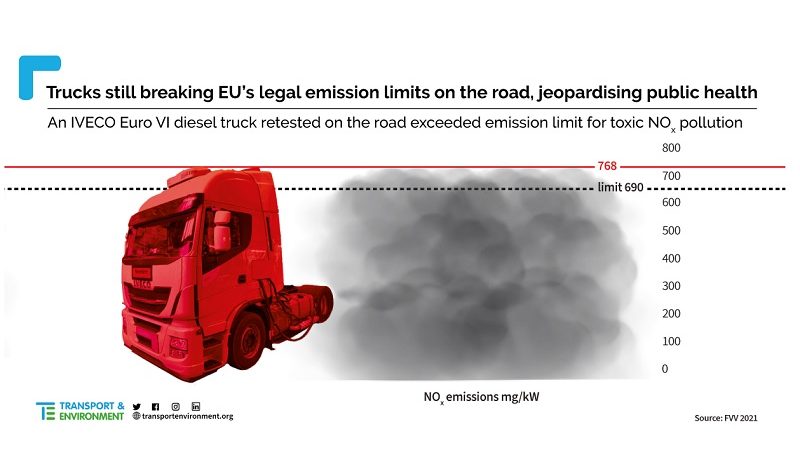Trucks’ over pollution, breaking EU’s legal emission limits in on-road tests. Emissions when driving in towns or cities were particularly alarming, with highly toxic nitrogen oxide (NOx) emissions at least double the legal limits, testing undertaken by the Technical University of Graz on behalf of T&E found.
Testing of an IVECO diesel long-haul truck found serious failures to comply with the current, lax ‘Euro VI’ emissions limits. In official tests, the truck exceeded the on-road NOx emission limit by 11% overall.
In one of the city driving tests the NOx emission control system – hardware in the exhaust – malfunctioned, resulting in NOx emissions which were 11 times higher than the current legal limit.
Anna Krajinska, emissions engineer at T&E, said: “These results are a damning indictment of an emission standard that allows trucks to drive the air pollution crisis. To combat asthma, heart disease and cancer, all pollution from diesel trucks needs to be urgently reduced. Alongside a clear strategy for achieving 100% Zero emission sales for most trucks by 2035, we need an ambitious new EU emission standard for heavy-duty vehicles to be implemented by 2025 to replace the outdated Euro VI standard agreed more than a decade ago.”
Toxic pollution from road transport is a serious public health concern, with 50,000 people in Europe dying prematurely every year due to nitrogen dioxide (NO2) pollution alone – a component of NOx. Road transport remains Europe’s largest source of NOx emissions. The testing results come in the wake of new World Health Organisation guidelines for NO2 that are 75% lower than current EU limits.
Heavy-duty vehicles represent just 2.4% of EU road vehicles, but they can contribute up to 40% to total NOx emissions [1]
It is particularly concerning that during testing, the truck had particularly high urban NOx emissions on tests replicating a typical supermarket delivery trip and low speed driving typical in towns and cities, where air pollution is often at its worst.
An ambitious new emission standard for all vehicles could cut total EU NOx emissions by 4.2 million tonnes by 2050 and avoid 35,000 premature deaths. T&E calls for the implementation of four key recommendations:
– Reduce emission limits to the lowest levels technically possible;
– Regulate all pollutants which are harmful to human health and the environment and can be effectively regulated at the tailpipe;
– Improve testing, approval and certification of vehicles to make sure buses and trucks meet emission limits whenever and wherever they are driven;
– Ensure that emission limits are met throughout the lifetime of the vehicle.
The European Commission is expected to publish a proposal for a new Euro VII emission standard for heavy-duty vehicles by the end of 2021. It is currently studying recommendations from independent emissions experts, the Consortium for Ultra Low Vehicle Emissions (CLOVE), which has proposed measures based on what is technically achievable.
Anna Krajinska said: “A new EU emission standard is urgently needed to reduce pollution from trucks and buses. Yet, intense opposition from an automotive industry that puts profit before people, could succeed in getting the European Commission to propose a weak standard which would do little to cut emissions. This would be a disaster for clean air and human health.”
[1] Proposal for a Regulation of the European Parliament and of the Council setting CO2 emission performance standards for new heavy duty vehicles
Transport & Environment’s (T&E) vision is a zero-emission mobility system that is affordable and has minimal impacts on our health, climate and environment.
Since we were created 30 years ago, T&E has shaped some of Europe’s most important environmental laws. We got the EU to set the world’s most ambitious CO2 standards for cars and trucks but also helped uncover the dieselgate scandal; we campaigned successfully to end palm oil diesel; secured a global ban on dirty shipping fuels and the creation of the world’s biggest carbon market for aviation – just to name a few.
Credibility is our key asset. We are a non-profit organisation and politically independent. We combine the power of robust, science-based evidence and a deep understanding of transport with memorable communications and impactful advocacy.
Our staff in Brussels, Rome, Madrid, Berlin, Warsaw and London collaborate with our 63 national member and supporter organisations in 24 countries across Europe. All together our members and supporters represent more than 3.5 million people.
We coordinate the International Coalition for Sustainable Aviation (ICSA), which has observer status at the International Civil Aviation Organisation (ICAO) and are members of the Clean Shipping Coalition (CSC), which has observer status at the International Maritime Organisation (IMO).
We hold a seat on the board of ECOS, and are members of the Green 10 group of European environmental NGOs, Agora Verkehrswende, the Platform for Electromobility, the Coalition for Energy Savings, the Renewable Grids Initiative and the Electrification Alliance.

